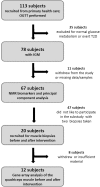Low level activity thresholds for changes in NMR biomarkers and genes in high risk subjects for Type 2 Diabetes
- PMID: 28924247
- PMCID: PMC5603534
- DOI: 10.1038/s41598-017-09753-6
Low level activity thresholds for changes in NMR biomarkers and genes in high risk subjects for Type 2 Diabetes
Abstract
Our objectives were to determine if there are quantitative associations between amounts and intensities of physical activities (PA) on NMR biomarkers and changes in skeletal muscle gene expressions in subjects with high risk for type 2 diabetes (T2D) performing a 3-month PA intervention. We found that PA was associated with beneficial biomarker changes in a factor containing several VLDL and HDL subclasses and lipids in principal component analysis (P = <0.01). Division of PA into quartiles demonstrated significant changes in NMR biomarkers in the 2nd - 4th quartiles compared to the 1st quartile representing PA of less than 2850 daily steps (P = 0.0036). Mediation analysis of PA-related reductions in lipoproteins showed that the effects of PA was 4-15 times greater than those of body weight or fat mass reductions. In a subset study in highly active subjects' gene expressions of oxidative fiber markers, Apo D, and G0/G1 Switch Gene 2, controlling insulin signaling and glucose metabolism were significantly increased. Slow walking at speeds of 2-3 km/h exceeding 2895 steps/day attenuated several circulating lipoprotein lipids. The effects were mediated rather by PA than body weight or fat loss. Thus, lower thresholds for PA may exist for long term prevention of cardio-metabolic diseases in sedentary overweight subjects.
Conflict of interest statement
The authors declare that they have no competing interests.
Figures




Similar articles
-
Light physical activity determined by a motion sensor decreases insulin resistance, improves lipid homeostasis and reduces visceral fat in high-risk subjects: PreDiabEx study RCT.Int J Obes (Lond). 2014 Aug;38(8):1089-96. doi: 10.1038/ijo.2013.224. Epub 2013 Nov 28. Int J Obes (Lond). 2014. PMID: 24285336 Free PMC article. Clinical Trial.
-
Interaction of single nucleotide polymorphisms in ADRB2, ADRB3, TNF, IL6, IGF1R, LIPC, LEPR, and GHRL with physical activity on the risk of type 2 diabetes mellitus and changes in characteristics of the metabolic syndrome: The Finnish Diabetes Prevention Study.Metabolism. 2008 Mar;57(3):428-36. doi: 10.1016/j.metabol.2007.10.022. Metabolism. 2008. PMID: 18249219 Clinical Trial.
-
Cross-sectional surveillance study to phenotype lorry drivers' sedentary behaviours, physical activity and cardio-metabolic health.BMJ Open. 2017 Jun 21;7(6):e013162. doi: 10.1136/bmjopen-2016-013162. BMJ Open. 2017. PMID: 28637722 Free PMC article.
-
Pharmacodynamic effects of oral contraceptive steroids on biochemical markers for arterial thrombosis. Studies in non-diabetic women and in women with insulin-dependent diabetes mellitus.Dan Med Bull. 2002 Feb;49(1):43-60. Dan Med Bull. 2002. PMID: 11894723 Review.
-
Role of exercise training in the prevention and treatment of insulin resistance and non-insulin-dependent diabetes mellitus.Sports Med. 1997 Nov;24(5):321-36. doi: 10.2165/00007256-199724050-00004. Sports Med. 1997. PMID: 9368278 Review.
Cited by
-
The Lipocalin Apolipoprotein D Functional Portrait: A Systematic Review.Front Physiol. 2021 Oct 7;12:738991. doi: 10.3389/fphys.2021.738991. eCollection 2021. Front Physiol. 2021. PMID: 34690812 Free PMC article.
-
Step detection and energy expenditure at different speeds by three accelerometers in a controlled environment.Sci Rep. 2021 Oct 8;11(1):20005. doi: 10.1038/s41598-021-97299-z. Sci Rep. 2021. PMID: 34625578 Free PMC article.
References
-
- Halverstadt A, Phares DA, Wilund KR, Goldberg AP, Hagberg JM. Endurance exercise training raises high-density lipoprotein cholesterol and lowers small low-density lipoprotein and very low-density lipoprotein independent of body fat phenotypes in older men and women. Metabolism. 2007;56:444–50. doi: 10.1016/j.metabol.2006.10.019. - DOI - PubMed
Publication types
MeSH terms
Substances
LinkOut - more resources
Full Text Sources
Other Literature Sources
Medical
Molecular Biology Databases

